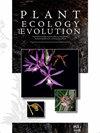Revision of Carapichea (Rubiaceae-Psychotrieae) in the Guianas, with two new combinations and transfer of three species to Notopleura
IF 1.1
4区 生物学
Q3 PLANT SCIENCES
引用次数: 0
Abstract
Background and aims – The genus Carapichea (Rubiaceae), recently resurrected and separated from Psychotria, currently includes 24 Neotropical species and is morphologically heterogeneous. A revision of the genus in the Guianas is presented here, as part of the authors’ work on the Rubiaceae treatment in the Flora of the Guianas series. Material and methods – This paper is based on a study of herbarium specimens from BBS, BM, BR, BRB, CAY, INPA, K, P, P-JJR, and U; type specimens from other herbaria were consulted online. Some of the species were also studied in the field by the authors. Normal practices of herbarium taxonomy have been applied. Results – Three species previously included in Carapichea (C. altsonii, C. nivea, and C. sandwithiana) show aberrant characters for the genus and are transferred to Notopleura; new combinations are published for the former two (N. altsonii and N. nivea). Eight species of Carapichea, one of them still imperfectly known, are recorded from the Guianas; a ninth species, C. araguariensis, is included in this revision as it is expected to occur in the region. New combinations are published for two species: Carapichea galbaoensis and C. squamelligera, based on Psychotria galbaoensis and P. squamelligera, respectively; the former species was previously included in synonymy of C. guianensis, which is here redefined in a narrower sense. The delimitation of C. ligularis is expanded to include C. pacimonica as a synonym. The first records of C. adinantha in French Guiana – and the Guiana Shield – are documented. The taxonomy of the two remaining species, C. tillettii and C. urniformis, is left unchanged. For every species a complete description is presented, as well as data on distribution, ecology, phenology, local names (when known), and a list of collections studied.圭亚那Carapihea(茜草科Psychotrieae)的修订、两个新组合和三个种转移到Notopleura
背景和目的-锦葵属(茜草科)最近从Psychtria中复活并分离出来,目前包括24个新热带物种,在形态上是异质的。作为作者在《圭亚那植物志》系列中对茜草科植物处理工作的一部分,本文对该属进行了修订。材料和方法——本文基于对BBS、BM、BR、BRB、CAY、INPA、K、P、P-JJR和U植物标本馆标本的研究;其他标本馆的模式标本也在网上查阅。作者还对其中一些物种进行了实地研究。植物标本馆分类学的常规做法已得到应用。结果——先前包含在Carapihea中的三个物种(C.altsonii、C.nivea和C.sandwithiana)显示出该属的异常特征,并被转移到Notopleura;发表了前两种(N.altsonii和N.nivea)的新组合。圭亚那记录了八种Carapihea,其中一种尚不清楚;第九个物种,C.araguariensis,被包括在这次修订中,因为它预计会出现在该地区。已经公布了两个物种的新组合:加尔宝Carapihea galbaoensis和C.squamelligera,分别基于加尔宝Psychtia galbaoeensis和P.squamelliger;前一种以前被包括在圭亚那C.guianensis的同义词中,在这里被重新定义为狭义的。对亮柱藻的划界进行了扩展,将宽柱藻作为同义词包括在内。法属圭亚那的C.adinantha和圭亚那地盾的第一次记录被记录在案。剩下的两个物种,C.tillettii和C.urniformis的分类学保持不变。每一个物种都有一个完整的描述,以及分布、生态学、酚学、当地名称(如果已知)的数据,以及研究的收藏品列表。
本文章由计算机程序翻译,如有差异,请以英文原文为准。
求助全文
约1分钟内获得全文
求助全文
来源期刊

Plant Ecology and Evolution
PLANT SCIENCES-
CiteScore
2.20
自引率
9.10%
发文量
27
审稿时长
>12 weeks
期刊介绍:
Plant Ecology and Evolution is an international peer-reviewed journal devoted to ecology, phylogenetics and systematics of all ‘plant’ groups in the traditional sense (including algae, cyanobacteria, fungi, myxomycetes), also covering related fields.
The journal is published by Meise Botanic Garden and the Royal Botanical Society of Belgium.
 求助内容:
求助内容: 应助结果提醒方式:
应助结果提醒方式:


